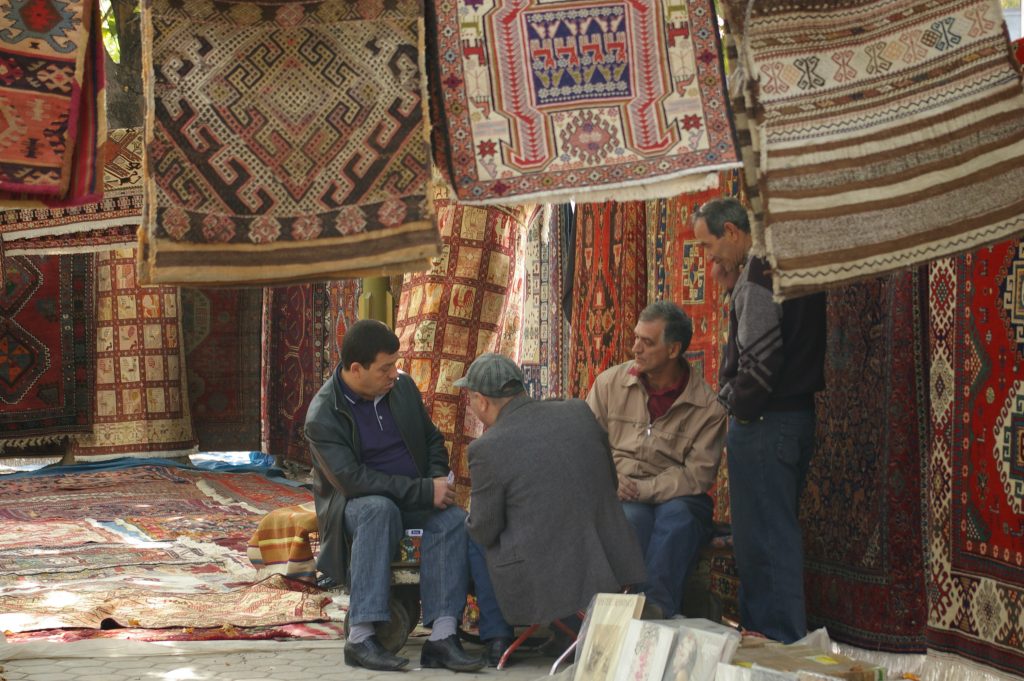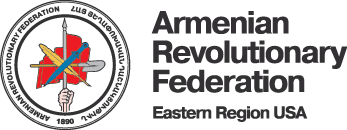The Global Nature of Armenian Culture

I was at a KFC in Yerevan the other day when an Iranian tourist approached the young woman at the counter and said, “Excuse me, please, can I have one changal?” The lady smiled and said, “Yes, changal,” and gave him the fork he requested.
How wonderful was that exchange? The setting: a multi-national fast food chain. The actors: two members of neighboring nations. The language: yet a third, as it were universal, entity, sprinkled with one word from let’s say a formerly universal language of communication.
I thought it was very telling—an example of the global nature of Armenian culture.

‘Here I am, in Yerevan, writing in English, an article that is going to be sent to offices in Boston, to be read by people—mostly Armenians—all around the world. (Photo: Debs-Eye)
Very often I note disappointment by diasporans in Armenia when it comes to the infiltration of outside elements into life in the Republic. I find that attitude quite misplaced. Most places diasporans come from tend to be multi-cultural, cosmopolitan, multi-lingual. Why should the expectation for Armenia itself be any different? Well, Armenia is meant to be the homeland, after all. There should be some kind of purity when it comes to Armenian culture there, should there not? I guess that is the traditional point of view.
It is simply not the case, however, and not a realistic expectation to have about the country. Firstly, it is not just Armenians who call the Republic of Armenia home. There are a number of ethno-national and religious minorities who have been living and working in Armenia for centuries. Secondly, Armenian culture itself has never really been monolithic or, as some might say, isolated from the rest of the world.
Armenia is pretty much in the middle of everything, at the crossroads of the classical East and West, on the trade routes in all directions, on the path of a number of empires, and certainly both exporter and importer of goods, people, and ideas. That has been the case throughout history.
Even the purest of the pure Armenian language, for example, will reveal foreign roots if one digs deep enough. The word meghedi I have heard brought up often as an example. How “Armenian” is that word? It’s been used for centuries, if not millennia. Yet, we consciously know that it is of Greek origin, the same root that gives us “melody” in English today, with the same meaning. So does that make it foreign, un-Armenian? The word has become a part of our heritage, even if its geographic roots are beyond the Armenian mountains. There are hundreds of other such words that we might consider purely Armenian, whereas they are in fact of, say, ancient Parthian or Assyrian origin—languages of which we are not consciously aware, as opposed to words in English, Turkish, French, Arabic, Russian, or Persian that many Armenians can point out when used in conversation.
It is true that living among mountains has allowed for some distance from our neighbors, and certainly from the hearts of the empires that have trampled in our midst. It is also true that, as recent DNA evidence suggests, the Armenian population was particularly isolated for some centuries starting around 1200 BC, with the mysterious collapse of civilization in the Near East. But, of course, cultural exchanges have been prevalent throughout the millennia that followed, whether in terms of religion, language, cuisine, art, or clothing. So many aspects of Armenian culture can be viewed through the lens of a general, shared heritage in the neighborhood—something many in the diaspora often fail to perceive, being unfamiliar with, for example, Georgian dance or Kurdish food.
Of course, none of this is to say that Armenians don’t have any unique cultural characteristics. Engraving and sculpture might be a widespread art form, but the tradition of the khatchkar, to give just one example, is quite uniquely Armenian—even acknowledged by UNESCO as such, and rightfully so. Or the practice of adam-hadig, when a baby who is cutting teeth is placed before objects that will reveal his or her future profession; this is something special that is not found in the region or elsewhere in the world, as far as I know.
And, certainly, it happens that even when foreign cultural traits are adopted into the Armenian fold, they tend to be adapted, rendering them much more unique in their expression. A nice example for that is Christianity. Who can deny that the national religion of Armenians is of non-Armenian origin? And yet who can deny how strongly it has become a part of the Armenian identity while being endowed with the Armenian language, music, and architecture? I’d say Christianity itself is all the more rich in having the Armenians participate in it.
A recently released movie from Armenia features scenes in Western Armenian, English, and Russian. This was also a very telling phenomenon, I found. Society in the Republic of Armenia is clearly open to the world in a way that—for many in the diaspora, by my experience—seems unexpected. It surprises me when my diasporan friends complain that being on the look-out for assimilation in the countries where they live follows them to Armenia as well, afraid that foreign elements will somehow destroy our millennia-old culture. Meanwhile, Armenians have long been moving here or there, to or from the homeland. At least a thousand years before the Armenian Genocide, if not more, the Armenian Diaspora existed, trading across oceans and continents. It would not be an exaggeration to say that the Armenians have been one of the driving forces behind globalization, at least in the economic sense. “Assimilation” can happen very broadly in different directions, to varying degrees, and not always in ways that are threatening or destructive.
‘[I]t happens that even when foreign cultural traits are adopted into the Armenian fold, they tend to be adapted, rendering them much more unique in their expression. A nice example for that is Christianity. Who can deny that the national religion of Armenians is of non-Armenian origin? And yet who can deny how strongly it has become a part of the Armenian identity while being endowed with the Armenian language, music, and architecture? I’d say Christianity itself is all the more rich in having the Armenians participate in it.’
Consider this text. Here I am, in Yerevan, writing in English, an article that is going to be sent to offices in Boston, to be read by people—mostly Armenians—all around the world. If that isn’t an expression of globalization, I don’t know what is. And before you give credit solely to the internet for that state of affairs, consider that Armenians had been publishing across Europe, the Middle East, Asia, and the Americas centuries before computers. This breadth of the global Armenian geography should be celebrated, not lamented as the consequence of some historical victimhood.
The Armenians are a global, globalized, and globalizing people, having always been open to the world, taking from culture in the neighborhood and beyond, and adding to culture regionally and across the planet. That aspect of the Armenian identity is something to take pride in just as energetically alongside the more unique traits of Armenian life.
Source: Armenian Weekly Mid-West
